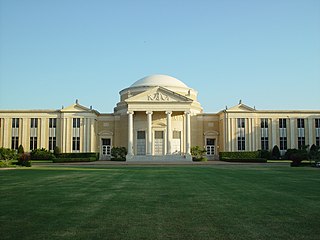
A seminary, school of theology, theological seminary, or divinity school is an educational institution for educating students in scripture, theology, generally to prepare them for ordination to serve as clergy, in academics, or mostly in Christian ministry. The English word is taken from the Latin seminarium, translated as seed-bed, an image taken from the Council of Trent document Cum adolescentium aetas which called for the first modern seminaries.

The University of Saint Mary of the Lake (USML) is a private Roman Catholic seminary in Mundelein, Illinois. It is the principal seminary and school of theology for the formation of priests in the Archdiocese of Chicago in Illinois. It was chartered by the Illinois General Assembly in 1844. USML is often referred to by the name of its graduate program, Mundelein Seminary. Its compound name is University of Saint Mary of the Lake/Mundelein Seminary.

National University of Kyiv-Mohyla Academy is a national, research university located in Kyiv, Ukraine. The Kyiv-Mohyla Academy, the school's predecessor, was established in 1615. The NaUKMA is located on the Academy's grounds in the ancient Podil neighborhood. In 1991, it was re-organized, and teaching began the following year. NaUKMA has the highest level of accreditation as outlined by the Ministry of Education and Science of Ukraine, and is one of the thirteen educational institutions in Ukraine having a status of a research and autonomous university. NaUKMA takes part in numerous international university collaborations, such as the European University Association. The university is bilingual in Ukrainian and English. It is one of Ukraine's few universities with internationally recognized diplomas.

The Collegium Hosianum was the Jesuit collegium founded in 1565, 1566 by Polish Cardinal Stanislaus Hosius in Braunsberg (Braniewo), Kingdom of Poland. The town was then part of the Polish Prince-Bishopric of Warmia under rule of Cardinal Hosius. The Collegium Hosianum was one of the biggest Jesuit schools and one of the most important centres of Counter-Reformation in Europe and was particularly established to educate Catholic clergy of different countries.
The Meadville Lombard Theological School is a Unitarian Universalist seminary in Chicago, Illinois.

Saint Tikhon's Orthodox Theological Seminary is an Orthodox Christian seminary located in South Canaan Township, Wayne County, Pennsylvania. It is one of three seminaries operated by the Orthodox Church in America, the others being St. Vladimir's Orthodox Theological Seminary in Crestwood, Yonkers, New York, and St. Herman's Orthodox Theological Seminary in Kodiak, Alaska. It is named after Tikhon of Zadonsk.
Saint Herman’s Orthodox Theological Seminary is an Orthodox Christian seminary located in Kodiak, Alaska, with a campus in Anchorage. Established as a pastoral school in 1972, the seminary now provides a number of educational programs to prepare students for work in the Orthodox Church, as readers, choir directors, church school teachers, and clergy.
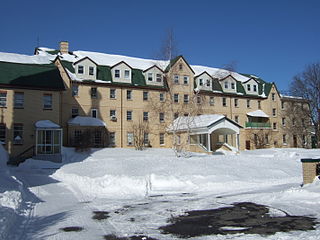
Holy Trinity Orthodox Seminary is an institution of higher learning under the jurisdiction of the Russian Orthodox Church Outside of Russia (ROCOR) and located near Jordanville, New York. Associated with Holy Trinity Monastery, the seminary offers a four-year program of study leading to the degree of Bachelor of Theology (B.Th.). It is accredited by the Commissioner for Education and the Board of Regents at the University of the State of New York. The Master of Divinity (M.Div.) degree program began in 2018.

The Divine Word Mission Seminary is a Roman Catholic seminary in Quezon City, Philippines, run by the Divine Word Missionaries, more popularly known as the Society of the Divine Word (SVD). The seminary offers a seminary track of junior and senior high school, an undergraduate course of A.B. Philosophy and a graduate program on M.A. Philosophy. I

The Roman College was a school established by St. Ignatius of Loyola in 1551, just 11 years after he founded the Society of Jesus (Jesuits). It quickly grew to include classes from elementary school through university level and moved to several successive locations to accommodate its burgeoning student population. With the patronage of Pope Gregory XIII, the final seat of the Roman College was built in 1584 near the center of Rome's most historic Pigna district, on what today is called Piazza del Collegio Romano, adding the church of St. Ignatius in 1626, and a renowned observatory in 1787. The college remained at this location for 286 years until the revolutionary Capture of Rome in 1870.

The Kiev Theological Academy (1819—1919) was one of the oldest higher educational institution of the Russian Orthodox Church, situated in Kyiv, then in the Russian Empire. It was considered as the most senior one among similar academies in Moscow, Saint Petersburg, and Kazan. It was located at the Kyiv Podol within the Kyiv Epiphany Monastery. In the Russian historiography, the Academy′s predecessor was the Academia Mohileana that was founded earlier in the 17th century.
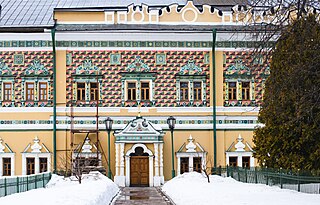
Moscow Theological Academy is a higher educational institution of the Russian Orthodox Church, training clergy, teachers, scholars, and officials.
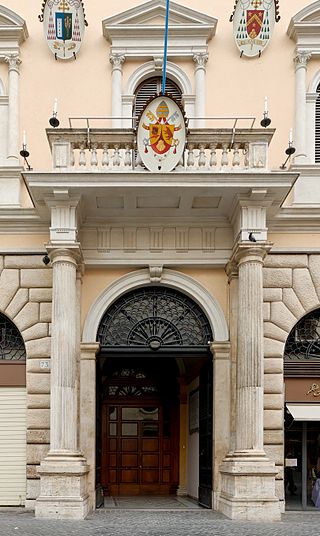
The Roman Colleges, also referred to as the Pontifical Colleges in Rome, are institutions established and maintained in Rome for the education of future ecclesiastics of the Catholic Church. Traditionally many were for students of a particular nationality. The colleges are halls of residence in which the students follow the usual seminary exercises of piety, study in private, and review the subjects treated in class. In some colleges there are special courses of instruction but the regular courses in philosophy and theology are given in a few large central institutions, such as Pontifical Urbaniana University, the Pontifical Gregorian University, the Pontifical Lateran University, and the Pontifical University of Saint Thomas Aquinas, Angelicum.
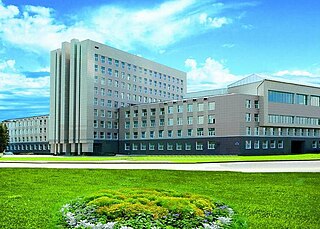
The Yaroslav-the-Wise Novgorod State University, also known informally as NovSU, was founded in 1993 by merging the two oldest higher education institutions of Veliky Novgorod: the Pedagogical and Polytechnic Institutes. Later, Novgorod Agricultural Academy was included into the structure of the University. At present it comprises seven Institutes and four Colleges of secondary vocational education.

Gevorkian Theological Seminary, also known as Gevorkian Seminary, is a theological university-institute of the Armenian Apostolic Church founded by Catholicos George IV in 1874. It is located in the town of Vagharshapat (Etchmiadzin) within the complex of the Mother See of Holy Etchmiadzin, Armenia.
The Seminary of the Immaculate Conception was a Catholic seminary in Lloyd Harbor, New York, accredited by the Association of Theological Schools in the United States and Canada, and serving the Diocese of Rockville Centre. It offered a number of academic degrees, primarily those of Master of Divinity (M.Div.) and Doctor of Ministry (D.Min.).
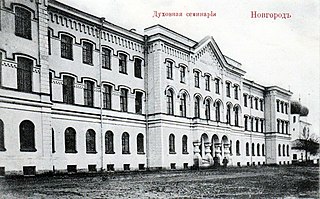
The Novgorod Theological Seminary is a secondary theological educational institution of the Novgorod diocese of the Russian Orthodox Church, which existed in 1740–1918.

The Chernihiv Collegium is one of the first educational institution in the Cossack Hetmanate for complete secondary and, subsequently, higher spiritual education, established on the left bank of the Dnieper. In the period of its highest prosperity, the collegium became a major educational and intellectual center and gained fame in Russia as “Chernigov Athens”. In historiography, the Chernihiv Collegium is considered one of the "first offspring" of the Kyiv-Mohyla Collegium. The collegium is located in the center of Chernihiv, on the edge of the rampart of the former fortress, next to the St. Boris and Gleb Cathedral at the Dytynets Park.
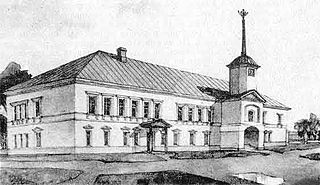
The Kharkov Collegium also known as Kharkiv Collegium or Kharkiv College was an educational institution in the Kharkov Governorate in the Russian Empire, which was founded in 1721, due to collaboration of Bishop Epiphanius of Belgorod and Prince Mikhail Golitsyn. As a great supporter of the Collegium was also known Prince Dmitry Golitsyn, whose monument stood in the central hall of the Collegium. The Kharkіv Collegium was closed in 1817 and was re-organised as the Kharkov Theological Seminary, a higher educational institution of the Russian Orthodox Church, training clergy, teachers, scholars, and officials.
















